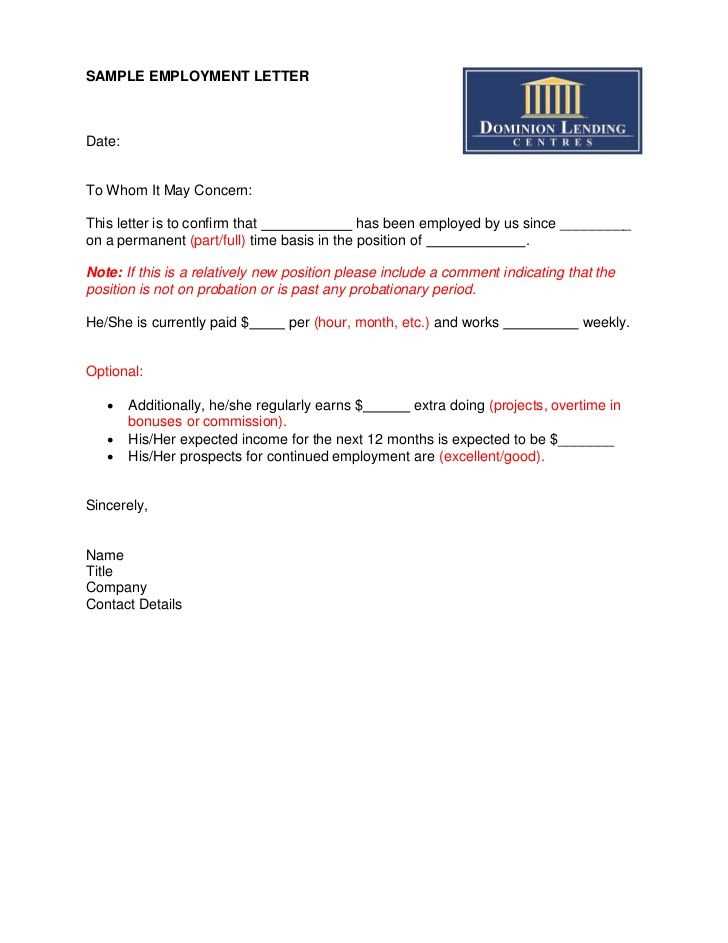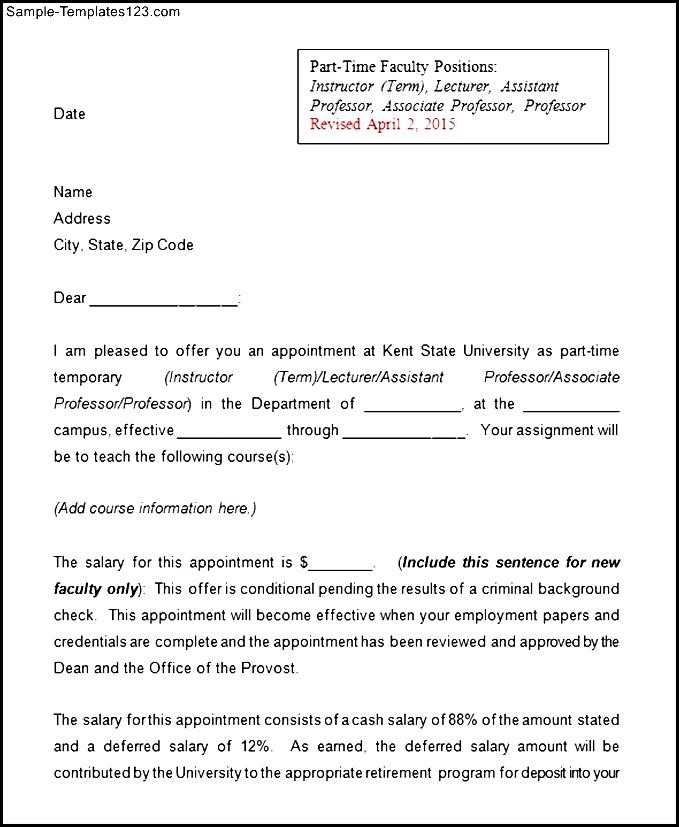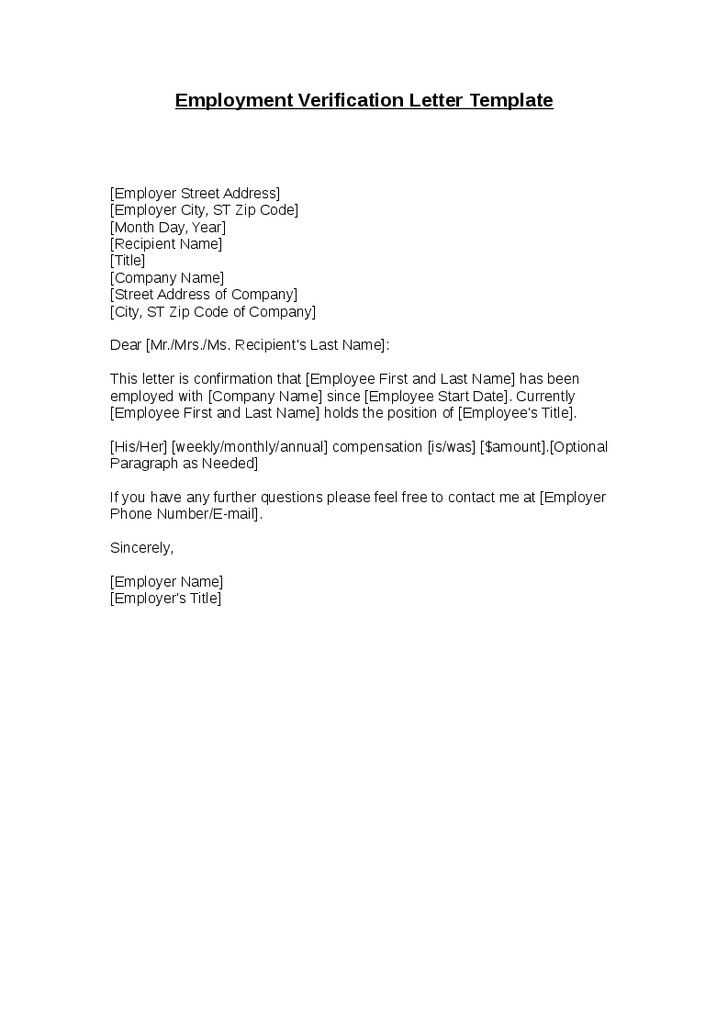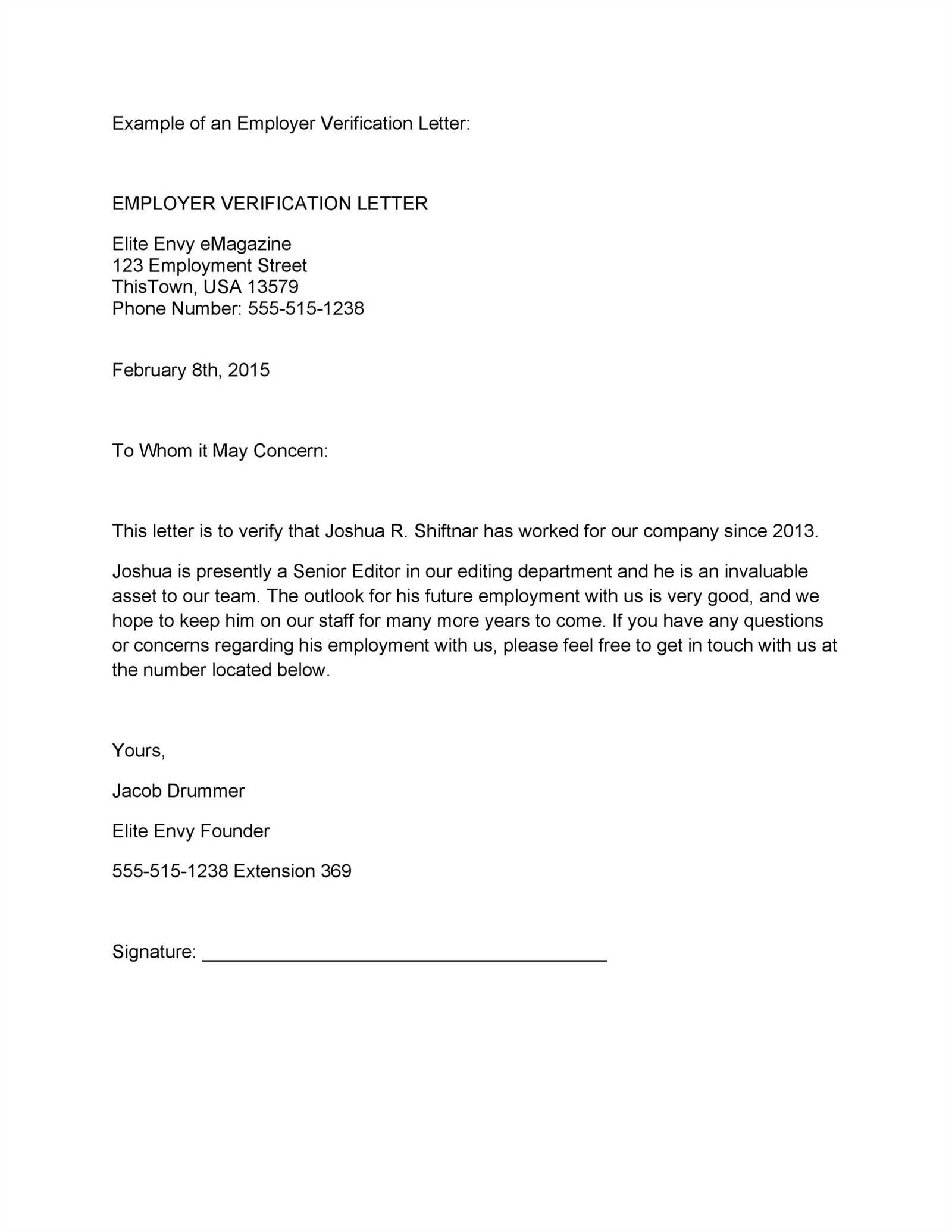Part-time employment letter template

If you’re looking to create a part-time employment letter, start by ensuring it includes clear details about the role and expectations. Begin with a concise introduction of the company, followed by specifics about the job title, working hours, and compensation structure.
Next, outline the expectations for the employee, including job responsibilities and reporting procedures. Be sure to mention any relevant benefits or conditions related to the part-time nature of the employment. It’s helpful to include the duration of employment, whether temporary or ongoing.
Conclude with a section that highlights any necessary actions the employee needs to take before starting. Include a space for signatures to formalize the agreement. A well-crafted part-time employment letter establishes clarity and ensures both parties understand the terms of the arrangement.
Here is the modified version with repeated words reduced, while preserving the original meaning and language:
To create a clear and concise part-time employment letter, focus on key details without redundancy. Use direct language to communicate the role, hours, and expectations. Avoid repeating phrases like “working hours” or “employment terms.” Instead, combine related information into single, streamlined sentences.
For example, instead of writing: “The working hours for this position are flexible, and the work schedule will be flexible,” simply state, “The position offers flexible working hours.” This reduces repetition and improves clarity.
Similarly, when mentioning duties, combine similar tasks into one sentence to avoid excessive elaboration. An example might be: “The role involves customer service, answering questions, and assisting clients” can be written as “The role involves providing customer service and assisting clients with inquiries.”
By reducing repetition, you maintain the message’s clarity while making the letter more concise and reader-friendly.
- Part-Time Employment Letter Template
When creating a part-time employment letter, ensure clarity by including specific details relevant to the employee’s role, working hours, and expectations. Below is a simple template to guide the process:
Part-Time Employment Letter
Dear [Employee Name],
We are pleased to offer you a part-time position at [Company Name] as a [Job Title]. Your employment will commence on [Start Date], and your working hours will be [X hours] per week, typically from [Day(s) of the week] between [Start Time] and [End Time].
Your main responsibilities will include:
- [Task 1]
- [Task 2]
- [Task 3]
The terms of your employment are as follows:
- Hourly wage: [Hourly Rate]
- Pay frequency: [Weekly/Bi-weekly/Monthly]
- Benefits (if applicable): [List of Benefits]
We are excited to have you join the team and look forward to your contribution. Please confirm your acceptance by signing and returning a copy of this letter by [Date].
Sincerely,
[Your Name]
[Your Job Title]
[Company Name]
Begin with a clear and concise introduction. State the position you are applying for, mentioning the company name and how you learned about the job. Keep this part direct, highlighting your interest in the role.
Next, move on to the body of the letter. Focus on your relevant skills and experience. Link your qualifications to the job requirements. Highlight any specific achievements or responsibilities from previous roles that demonstrate your suitability for the part-time position.
Include a brief section on your availability. Specify the hours or days you are available to work, and mention any flexibility you may have. This will help the employer understand your commitment to the schedule.
In the closing paragraph, express gratitude for the opportunity to apply and mention your enthusiasm for the possibility of discussing the role further. Provide your contact details, such as your phone number or email, and express your willingness to provide additional information if needed.
Finish with a polite sign-off, such as “Sincerely” or “Best regards,” followed by your name.
Begin by stating the position you are applying for and the company’s name. This sets a clear context for the reader right away. Make sure to mention the specific dates or duration of the employment, especially if it’s a part-time role. It’s helpful to provide clear working hours and expectations regarding the job’s flexibility.
Company Contact Information

Include the company’s official address, contact number, and email. This ensures the employer can easily reach you for follow-ups or clarifications. It’s also a good idea to reference the hiring manager’s name if known to personalize the letter.
Salary and Benefits
Outline the agreed-upon wage or hourly rate, as well as any benefits the position offers, such as paid leave or other perks. This clarifies expectations and prevents misunderstandings later.
Focus on being clear and concise. One common mistake is making the letter too long. Employers appreciate a letter that communicates your intentions quickly without unnecessary details.
- Using Vague Language: Avoid generic phrases that don’t add clarity. Be specific about the role you’re applying for and the skills you bring to the table.
- Ignoring Formatting: A cluttered letter can make it hard for the reader to follow. Ensure your letter has proper paragraph breaks and consistent font usage.
- Failing to Address the Employer’s Needs: Don’t focus solely on your qualifications. Highlight how your skills align with the company’s needs or the job requirements.
- Using Too Formal or Too Casual Language: Maintain a professional tone without sounding too stiff. Strike a balance between politeness and approachability.
- Not Customizing the Letter: Avoid sending a generic letter. Tailor it to each company, demonstrating that you have done your research about their values and culture.
- Neglecting Proofreading: Small errors can make a big impact. Proofread your letter to ensure there are no spelling or grammatical mistakes that could make you appear careless.
By keeping these points in mind, you can create a letter that stands out for all the right reasons.
Customize your letter by focusing on skills and experiences that match the industry’s needs. In retail, highlight customer service abilities and flexibility. For tech roles, emphasize problem-solving skills and technical knowledge. In healthcare, stress your compassion, attention to detail, and ability to work in fast-paced environments. Use industry-specific keywords that demonstrate you understand the role and can add value.
Research the company’s values and culture. For example, a nonprofit might value a passion for social impact, while a corporate job may emphasize efficiency and leadership. Adjust the tone of your letter to reflect these differences, balancing professionalism with enthusiasm based on the company’s atmosphere.
Finally, include relevant examples. In education, you could mention your teaching or mentoring experience, while in hospitality, highlight how you handled customer interactions or worked as part of a team. Specific examples help showcase your fit for the job and industry.
If your part-time job letter is rejected, stay calm and consider your next steps carefully. It’s a common situation, and how you handle it can impact your future opportunities.
1. Review the Feedback
Look at any feedback provided in the rejection letter. Employers may highlight specific reasons for their decision. This can guide you in making adjustments for future applications or job letters.
2. Improve Your Letter
If you received feedback on your letter’s content, take time to revise it. Focus on clearly expressing your skills and experience. Tailor the letter to each job and ensure it aligns with the employer’s requirements.
3. Follow Up

If no feedback was provided, it’s okay to reach out and ask for insights. A brief, polite email requesting constructive criticism can help you learn more about what the employer is looking for.
4. Apply Again
After making improvements, consider reapplying to the same company or similar positions. Sometimes rejection simply means you need to try again with a stronger application.
5. Keep Applying

Don’t be discouraged by one rejection. Keep applying to other part-time positions and continue improving your job letter with each new submission. Persistence often leads to success.
| Action | Benefit |
|---|---|
| Review feedback | Learn what to improve |
| Improve your letter | Increase your chances of success |
| Follow up | Gain insights and make adjustments |
| Reapply | Show persistence and adaptability |
| Keep applying | Build experience and increase opportunities |
Use a clear and concise structure. Begin with your contact information, followed by the employer’s details. In the body, address the specific position you are applying for and highlight relevant skills or experience. Close with a polite statement expressing your enthusiasm and a call to action, such as requesting an interview. Keep your letter to one page and use simple language to convey your message effectively.
Format your letter professionally. Use a standard font like Arial or Times New Roman, size 12. Ensure there is enough spacing between paragraphs to enhance readability. Align your text to the left, and avoid excessive indentations. Use a consistent format for headings, and check that your letter is free from any grammatical or typographical errors.
Before submitting, review the job posting for any specific submission instructions. If the employer requests a PDF format, convert your document accordingly. Ensure that the file is named appropriately, such as “YourName_JobTitle_Application”. Double-check the recipient’s email address or physical address to ensure accuracy.
Finally, follow up with a brief email if you haven’t received a response within a week or two. Keep your tone polite and express continued interest in the position.
Make sure your part-time employment letter is clear and straightforward. List the job title, working hours, and the start date. Include the hourly wage and payment schedule to avoid confusion. Specify the work location and any conditions related to remote work, if applicable.
Outline the expectations and responsibilities, keeping it brief but precise. Be transparent about contract duration, whether it’s temporary or ongoing. It’s also helpful to mention the company’s policy on benefits or time off, if relevant.
End with clear instructions for both parties on how to proceed, such as signing and returning the letter. A polite and professional tone will set the right tone for your communication.